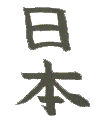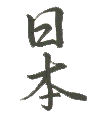Shodō is writing kanji in the traditional manner using brush and ink. It can be considered an art form, separate from simply putting pen to paper to communicate. Most children in Japan learn calligraphy in elementary school. It is also a popular hobby among adults.
Kinjō Kaichō compared the three types of shodō to the three levels of kata performance, shokyu, chūkyū and jōkyū. First, a little about kanji and shodō.
Kanji
Ancient Japan did not have a written language of its own. The Chinese writing system was first introduced to Japan in the 5th century via the Korean peninsula. Therefore, China, Korea and Japan all share the pictorial characters called kanji, with variations that have crept in over the course of time.
A single kanji consists of several to many strokes produced in a defined order and carefully balanced. The strokes may include sweeps, bars, corners, hooks, curves and dots. Kanji can be as simple as two strokes but may also be very complex. For example, the kanji 孝 has seven strokes: three horizontal bars, a vertical bar, a sweep, a corner and a hook. Historically, the single most complex kanji had 108 strokes, but fortunately this kanji was replaced by a more manageable modern version.
A word in Japanese can be made up of one or more kanji. Thus, karate is written as two kanji (空手) and kobudō as three kanji (古武道).
Shodō (書道)
There are three main types of shodō:
Kaisho
The strokes of a kanji must be written in a set order with a defined relationship and balance. The order is so important that apps for learning kanji will often include a video showing, in order, each stroke of the kanji. Japanese schoolchildren learn to write kanji on special four-square gridded paper to practice balance and the relationship between strokes. The end result of this rigid emphasis on accuracy and detail is the clearly written, readable script called kaisho. Kaisho has the appearance of having been produced by machine. Indeed, a popular Japanese font is called kaisho. Kaisho is considered to be similar to Western-style printing.
Gyōsho
The difference between kaisho and gyōsho is similar to the difference between Western-style printing and cursive. Unlike kaisho, the gyōsho calligrapher does not lift his pen between every stroke of a kanji, resulting in a smoother script that is faster to write. One stroke may flow into another, but only in acceptable ways. The resulting character is still easily recognizable. Unlike Western-style cursive which typically connects a whole word, the gyōsho pen does not flow from one kanji to the next, but within a single kanji. Therefore, gyōsho is often referred to as semi-cursive. The strokes in every symbol are drawn more quickly and must convey fluidity and motion. You can be more creative with this style, and more relaxed in your approach. Gyosho is the most popular style of Japanese calligraphy for the hobbyist.
Sōsho
Sōsho is the most abstract of the three calligraphy styles. A departure from the rigidly controlled strokes of kaisho or the quick, flowing strokes of gyōsho, sōsho strokes still flow together but in an abstract and expressive way. Some strokes may be omitted altogether. The kanji themselves may flow together, connecting in an artistic way, resulting in a highly stylized script resembling art more than writing. Sōsho is an art of movement involving the whole body, not just the wrist and hand. The sōsho artist frees his mind and “goes with the flow.” There is no room for hesitation or thought. The result is beautiful, but often not easy to read and understand. There is no true equivalent in Western-style calligraphy. Sōsho is sometimes referred to as “grass style” because it is thought to reflect wind blowing over grass.
Examples of Shodō
| Kaisho | 楷書 | printing | square style |  |
| Gyōsho | 行書 | semi-cursive | moving style |  |
| Sōsho | 草書 | cursive (highly stylized) | grass style |  |
How Shodō Relates to Shokyū, Chūkyū and Jōkyū
The relationship of kaisho to shokyū is obvious. The goal is accuracy of technique. Many repetitions are required to reach an accurate duplication of the model.
Western calligraphy stripped of any useless decorative strokes but gave much importance to proportion, slant and spacing. However, Jenkins’s method did not care for speed, to the contrary, slowing down was the best way to obtain the almost mathematical perfection of form that was desired… These theories were echoed in other copybooks during the first half of the 19th century, they are at the roots of the Engrosser’s script that is still used today https://pennavolans.com/19th-20th-penmanship-in-the-usa/
To practice Japanese zen calligraphy, you must have a clear, focused mind. Such a state of mind will allow you to execute your brush strokes confidently, fluidly and emotively. Every symbol is entirely unique, depending on who drew it and when they drew it. Therefore, each symbol that is drawn can never be identically replicated.
The strokes in every symbol are drawn more quickly and must convey fluidity and motion. You can be more creative with this style, and more relaxed in your approach.
you cannot develop your sosho approach without mastering the kaisho approach first.
